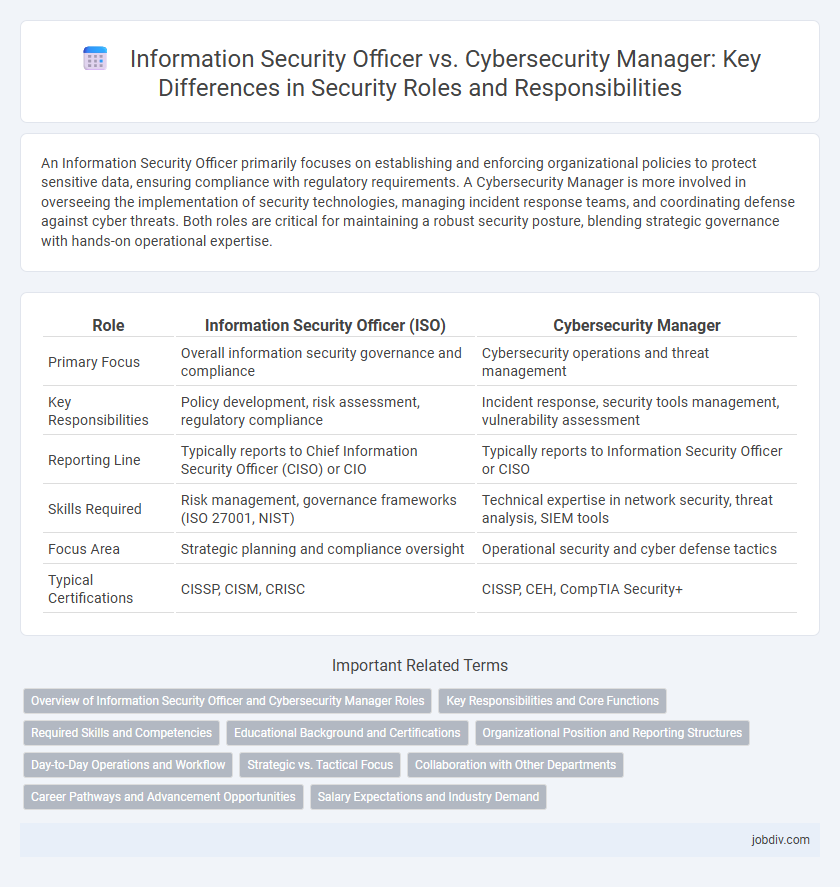An Information Security Officer primarily focuses on establishing and enforcing organizational policies to protect sensitive data, ensuring compliance with regulatory requirements. A Cybersecurity Manager is more involved in overseeing the implementation of security technologies, managing incident response teams, and coordinating defense against cyber threats. Both roles are critical for maintaining a robust security posture, blending strategic governance with hands-on operational expertise.
Table of Comparison
| Role | Information Security Officer (ISO) | Cybersecurity Manager |
|---|---|---|
| Primary Focus | Overall information security governance and compliance | Cybersecurity operations and threat management |
| Key Responsibilities | Policy development, risk assessment, regulatory compliance | Incident response, security tools management, vulnerability assessment |
| Reporting Line | Typically reports to Chief Information Security Officer (CISO) or CIO | Typically reports to Information Security Officer or CISO |
| Skills Required | Risk management, governance frameworks (ISO 27001, NIST) | Technical expertise in network security, threat analysis, SIEM tools |
| Focus Area | Strategic planning and compliance oversight | Operational security and cyber defense tactics |
| Typical Certifications | CISSP, CISM, CRISC | CISSP, CEH, CompTIA Security+ |
Overview of Information Security Officer and Cybersecurity Manager Roles
Information Security Officers are responsible for developing and enforcing policies to protect an organization's data assets, ensuring compliance with regulations such as GDPR and HIPAA. Cybersecurity Managers oversee technical teams to implement defenses against cyber threats, manage incident response, and coordinate security operations. Both roles focus on safeguarding information, but Information Security Officers emphasize governance and risk management, while Cybersecurity Managers concentrate on operational cybersecurity controls and threat mitigation.
Key Responsibilities and Core Functions
Information Security Officers primarily focus on developing and enforcing organizational policies, risk management frameworks, and compliance with regulatory requirements to protect sensitive data. Cybersecurity Managers oversee the implementation of technical defenses, incident response strategies, and security operations teams to prevent and respond to cyber threats. Both roles collaborate to ensure comprehensive protection, with the Information Security Officer emphasizing governance and the Cybersecurity Manager concentrating on operational security measures.
Required Skills and Competencies
Information Security Officers require expertise in risk management, compliance, and policy development to safeguard organizational data and ensure regulatory adherence. Cybersecurity Managers focus on advanced technical skills such as threat detection, incident response, and network security management to mitigate cyber threats and coordinate defense strategies. Both roles demand strong leadership, communication abilities, and continual knowledge of evolving security technologies and frameworks.
Educational Background and Certifications
Information Security Officers typically hold degrees in information security, computer science, or related fields, with certifications such as CISSP, CISM, or CompTIA Security+ being highly valued. Cybersecurity Managers often possess a similar educational foundation but emphasize advanced certifications like Certified Ethical Hacker (CEH), GIAC Security Essentials (GSEC), or PMP to align with managerial responsibilities. Both roles require ongoing professional development to stay current with evolving threats and security technologies.
Organizational Position and Reporting Structures
An Information Security Officer typically reports directly to the Chief Information Security Officer (CISO) or Chief Technology Officer (CTO) and is responsible for implementing security policies across the organization. A Cybersecurity Manager usually oversees a team of cybersecurity analysts and reports to the Information Security Officer or the IT Director, focusing on the tactical execution of cybersecurity measures. Organizationally, the Information Security Officer holds a more strategic role, while the Cybersecurity Manager operates at a mid-management level managing day-to-day security operations.
Day-to-Day Operations and Workflow
Information Security Officers primarily oversee the development and enforcement of security policies, ensuring compliance with regulatory requirements and managing risk assessments. Cybersecurity Managers focus on the operational aspect, leading incident response teams, monitoring security systems, and coordinating threat detection and mitigation efforts. Day-to-day workflows for Information Security Officers involve policy review and audit coordination, whereas Cybersecurity Managers prioritize real-time security monitoring and hands-on malware analysis.
Strategic vs. Tactical Focus
An Information Security Officer primarily maintains a strategic focus by developing and enforcing security policies aligned with organizational goals, ensuring long-term protection against threats. In contrast, a Cybersecurity Manager adopts a tactical approach, overseeing day-to-day security operations, incident response, and the implementation of specific safeguards. Both roles are critical, but the Information Security Officer drives overarching security vision while the Cybersecurity Manager manages practical execution.
Collaboration with Other Departments
Information Security Officers and Cybersecurity Managers collaborate closely with departments such as IT, legal, and compliance to develop comprehensive security strategies that address organizational risks. Information Security Officers focus on policy enforcement and risk management, while Cybersecurity Managers lead technical teams to implement security controls and incident response. Effective cross-departmental collaboration ensures alignment of security initiatives with business objectives and regulatory requirements.
Career Pathways and Advancement Opportunities
Information Security Officers typically focus on governance, risk management, and compliance, often progressing from roles in IT auditing or security analysis to senior positions like Chief Information Security Officer (CISO). Cybersecurity Managers usually start with technical backgrounds in network security or incident response, advancing towards leadership roles in security operations or threat intelligence management. Career pathways for both roles offer advancement through gaining certifications such as CISSP, CISM, and experience in regulatory frameworks like GDPR, HIPAA, and industry-specific standards.
Salary Expectations and Industry Demand
Information Security Officers typically command average salaries ranging from $85,000 to $130,000 annually, reflecting their responsibility for developing and enforcing an organization's security policies. Cybersecurity Managers often earn higher salaries, between $100,000 and $150,000, due to their strategic role in managing cybersecurity teams and overseeing threat mitigation efforts. The industry demand for Cybersecurity Managers is rapidly increasing, driven by rising cyber threats and complex regulatory environments, while Information Security Officers remain critical for maintaining overall security governance.
Information Security Officer vs Cybersecurity Manager Infographic

 jobdiv.com
jobdiv.com